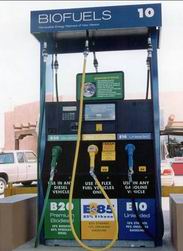Bond Enthalpies and Fuels
- Page ID
- 50916
\( \newcommand{\vecs}[1]{\overset { \scriptstyle \rightharpoonup} {\mathbf{#1}} } \)
\( \newcommand{\vecd}[1]{\overset{-\!-\!\rightharpoonup}{\vphantom{a}\smash {#1}}} \)
\( \newcommand{\id}{\mathrm{id}}\) \( \newcommand{\Span}{\mathrm{span}}\)
( \newcommand{\kernel}{\mathrm{null}\,}\) \( \newcommand{\range}{\mathrm{range}\,}\)
\( \newcommand{\RealPart}{\mathrm{Re}}\) \( \newcommand{\ImaginaryPart}{\mathrm{Im}}\)
\( \newcommand{\Argument}{\mathrm{Arg}}\) \( \newcommand{\norm}[1]{\| #1 \|}\)
\( \newcommand{\inner}[2]{\langle #1, #2 \rangle}\)
\( \newcommand{\Span}{\mathrm{span}}\)
\( \newcommand{\id}{\mathrm{id}}\)
\( \newcommand{\Span}{\mathrm{span}}\)
\( \newcommand{\kernel}{\mathrm{null}\,}\)
\( \newcommand{\range}{\mathrm{range}\,}\)
\( \newcommand{\RealPart}{\mathrm{Re}}\)
\( \newcommand{\ImaginaryPart}{\mathrm{Im}}\)
\( \newcommand{\Argument}{\mathrm{Arg}}\)
\( \newcommand{\norm}[1]{\| #1 \|}\)
\( \newcommand{\inner}[2]{\langle #1, #2 \rangle}\)
\( \newcommand{\Span}{\mathrm{span}}\) \( \newcommand{\AA}{\unicode[.8,0]{x212B}}\)
\( \newcommand{\vectorA}[1]{\vec{#1}} % arrow\)
\( \newcommand{\vectorAt}[1]{\vec{\text{#1}}} % arrow\)
\( \newcommand{\vectorB}[1]{\overset { \scriptstyle \rightharpoonup} {\mathbf{#1}} } \)
\( \newcommand{\vectorC}[1]{\textbf{#1}} \)
\( \newcommand{\vectorD}[1]{\overrightarrow{#1}} \)
\( \newcommand{\vectorDt}[1]{\overrightarrow{\text{#1}}} \)
\( \newcommand{\vectE}[1]{\overset{-\!-\!\rightharpoonup}{\vphantom{a}\smash{\mathbf {#1}}}} \)
\( \newcommand{\vecs}[1]{\overset { \scriptstyle \rightharpoonup} {\mathbf{#1}} } \)
\( \newcommand{\vecd}[1]{\overset{-\!-\!\rightharpoonup}{\vphantom{a}\smash {#1}}} \)
\(\newcommand{\avec}{\mathbf a}\) \(\newcommand{\bvec}{\mathbf b}\) \(\newcommand{\cvec}{\mathbf c}\) \(\newcommand{\dvec}{\mathbf d}\) \(\newcommand{\dtil}{\widetilde{\mathbf d}}\) \(\newcommand{\evec}{\mathbf e}\) \(\newcommand{\fvec}{\mathbf f}\) \(\newcommand{\nvec}{\mathbf n}\) \(\newcommand{\pvec}{\mathbf p}\) \(\newcommand{\qvec}{\mathbf q}\) \(\newcommand{\svec}{\mathbf s}\) \(\newcommand{\tvec}{\mathbf t}\) \(\newcommand{\uvec}{\mathbf u}\) \(\newcommand{\vvec}{\mathbf v}\) \(\newcommand{\wvec}{\mathbf w}\) \(\newcommand{\xvec}{\mathbf x}\) \(\newcommand{\yvec}{\mathbf y}\) \(\newcommand{\zvec}{\mathbf z}\) \(\newcommand{\rvec}{\mathbf r}\) \(\newcommand{\mvec}{\mathbf m}\) \(\newcommand{\zerovec}{\mathbf 0}\) \(\newcommand{\onevec}{\mathbf 1}\) \(\newcommand{\real}{\mathbb R}\) \(\newcommand{\twovec}[2]{\left[\begin{array}{r}#1 \\ #2 \end{array}\right]}\) \(\newcommand{\ctwovec}[2]{\left[\begin{array}{c}#1 \\ #2 \end{array}\right]}\) \(\newcommand{\threevec}[3]{\left[\begin{array}{r}#1 \\ #2 \\ #3 \end{array}\right]}\) \(\newcommand{\cthreevec}[3]{\left[\begin{array}{c}#1 \\ #2 \\ #3 \end{array}\right]}\) \(\newcommand{\fourvec}[4]{\left[\begin{array}{r}#1 \\ #2 \\ #3 \\ #4 \end{array}\right]}\) \(\newcommand{\cfourvec}[4]{\left[\begin{array}{c}#1 \\ #2 \\ #3 \\ #4 \end{array}\right]}\) \(\newcommand{\fivevec}[5]{\left[\begin{array}{r}#1 \\ #2 \\ #3 \\ #4 \\ #5 \\ \end{array}\right]}\) \(\newcommand{\cfivevec}[5]{\left[\begin{array}{c}#1 \\ #2 \\ #3 \\ #4 \\ #5 \\ \end{array}\right]}\) \(\newcommand{\mattwo}[4]{\left[\begin{array}{rr}#1 \amp #2 \\ #3 \amp #4 \\ \end{array}\right]}\) \(\newcommand{\laspan}[1]{\text{Span}\{#1\}}\) \(\newcommand{\bcal}{\cal B}\) \(\newcommand{\ccal}{\cal C}\) \(\newcommand{\scal}{\cal S}\) \(\newcommand{\wcal}{\cal W}\) \(\newcommand{\ecal}{\cal E}\) \(\newcommand{\coords}[2]{\left\{#1\right\}_{#2}}\) \(\newcommand{\gray}[1]{\color{gray}{#1}}\) \(\newcommand{\lgray}[1]{\color{lightgray}{#1}}\) \(\newcommand{\rank}{\operatorname{rank}}\) \(\newcommand{\row}{\text{Row}}\) \(\newcommand{\col}{\text{Col}}\) \(\renewcommand{\row}{\text{Row}}\) \(\newcommand{\nul}{\text{Nul}}\) \(\newcommand{\var}{\text{Var}}\) \(\newcommand{\corr}{\text{corr}}\) \(\newcommand{\len}[1]{\left|#1\right|}\) \(\newcommand{\bbar}{\overline{\bvec}}\) \(\newcommand{\bhat}{\widehat{\bvec}}\) \(\newcommand{\bperp}{\bvec^\perp}\) \(\newcommand{\xhat}{\widehat{\xvec}}\) \(\newcommand{\vhat}{\widehat{\vvec}}\) \(\newcommand{\uhat}{\widehat{\uvec}}\) \(\newcommand{\what}{\widehat{\wvec}}\) \(\newcommand{\Sighat}{\widehat{\Sigma}}\) \(\newcommand{\lt}{<}\) \(\newcommand{\gt}{>}\) \(\newcommand{\amp}{&}\) \(\definecolor{fillinmathshade}{gray}{0.9}\)Fossil Fuels have been used for years because of their high exothermic values when combusted. When the hydrocarbons in gasoline are combusted in the presence of oxygen, the bonds rearrange to form carbon dioxide and water, along with a large amount of energy. However, the burning of gasoline emits greenhouse gases into the atmosphere which is a concern. There is a focus now on developing alternative energy to power vehicles in order to reduce greenhouse gas emissions.
Fossil Fuels vs. Alternative Fuels
Alternative means to power vehicles is a hot topic in environmental chemistry. Hybrid vehicles, ethanol, biodiesel, natural gas, and hydrogen fuel cells are all options for powering vehicles that reduce the environmental impact of greenhouse gases in the environment1. The main concern for these alternative fuels is their efficiency vs. cost when compared to fossil fuels. Table \(\PageIndex{1}\) shows the chemical structure for several fuels, as well as the energy content of each.

| Gasoline | No. 2 Diesel | Biodiesel | Ethanol | Hydrogen | Liquefied Natural Gas (LNG) | Liquefied Petroleum Gas | |
| Chemical Structure | C4 to C12 | C8 to C25 | Methyl esters of C12 to C22 fatty acids | CH3CH2OH | H2 | CH4 | C3H8 (majority) and C4H10 (minority) |
| Energy Content (Higher Heat Value) | 124,340 Btu/gal (g) | 137,380 Btu/gal (g) | 127,960 Btu/gal for B100 (g) | 84,530 Btu/gal for E100 (g) | 61,013 Btu/lb (g) | 84,820 Btu/gal (g) | 91,410 Btu/gal (g |
| Energy Contained in Various Alternative Fuels as Compared to One Gallon of Gasoline | 100% | 1 gallon of diesel has 113% of the energy of one gallon of gasoline. | B100 has 103% of the energy in one gallon of gasoline or 93% of the energy of one gallon of diesel. B20 has 109% of the energy of one gallon of gasoline or 99% of the energy of one gallon of diesel. | 1 gallon of E85 has 77% of the energy of one gallon of gasoline. | 1 kg or 2.198 lbs. of H2 has 100% of the energy of one gallon of gasoline. | 1 gallon of LNG has 64% of the energy of one gallon of gasoline. | 1 gallon of propane has 73% of the energy of one gallon of gasoline. |
*Table created at: http://www.afdc.energy.gov/afdc/fuels/properties.html
Ethanol
Ethanol can be used in varying percent grades by vehicles. Gasohol is 10% ethanol, produces less carbon emissions than typical gasoline, but decreases the miles per gallon (MPG) of the vehicle slightly. E85 is up to 85% ethanol, can be less expensive depending upon where you live, but lowers the MPG up to 30% compared to typical gasoline. Let’s look at the bond enthalpy change for the burning of fossil fuels vs. the burning of E85 to understand the drop in MPG.
Example \(\PageIndex{1}\): Calculating ΔH
The chemical structure of E85 is \(CH_3CH_2OH\). The complete combustion of E85 with pure oxygen is shown as follows:
\[CH_3CH_2OH + 3O_2 → 2CO_2 + 3H_2O \nonumber\]
Find the ΔH for the reaction.
Solution
Bonds Broken Bonds Formed
1 C―C 348 kJ mol–1 4 C=O –3196 kJ mol–1
5 C―H 2065 kJ mol–1 6 H―O –2778 kJ mol–1
3 O=O 1485 kJ mol–1 ____________________________
1 C=O 799 kJ mol–1
Total 4697 kJ mol–1 Total –5974 kJ mol–1
The ΔH is 4593 kJ mol–1 – 5974 kJ mol–1 = -1277 kJ mol–1
Exercise \(\PageIndex{1}\)
1. What is the ΔH for the combustion of one mole of octane?
2. a. How many moles of ethanol would you need to drive the same amount of miles as one gallon of octane would take you? (There are roughly 23.2 moles of octane in 1 gallon)
b. What would the total ΔH for the combustion of the amount of ethanol found in the previous question?
From ChemPRIME:15.10: Bond Enthalpies and Exothermic or Endothermic Reactions
Resources
- US Department of Energy. Alternative Fuels. Retrieved 6/13/2012 from: http://www.fueleconomy.gov/feg/current.shtml
- US Department of Energy. Alternative and Advanced Fuels. Retrieved 6/13/2012 from: http://www.afdc.energy.gov/afdc/fuels/properties.html
- Wikipedia. Accessed 7/19/2012. en.Wikipedia.org/wiki/Gasoline
Contributors and Attributions
Ed Vitz (Kutztown University), John W. Moore (UW-Madison), Justin Shorb (Hope College), Xavier Prat-Resina (University of Minnesota Rochester), Tim Wendorff, and Adam Hahn.


